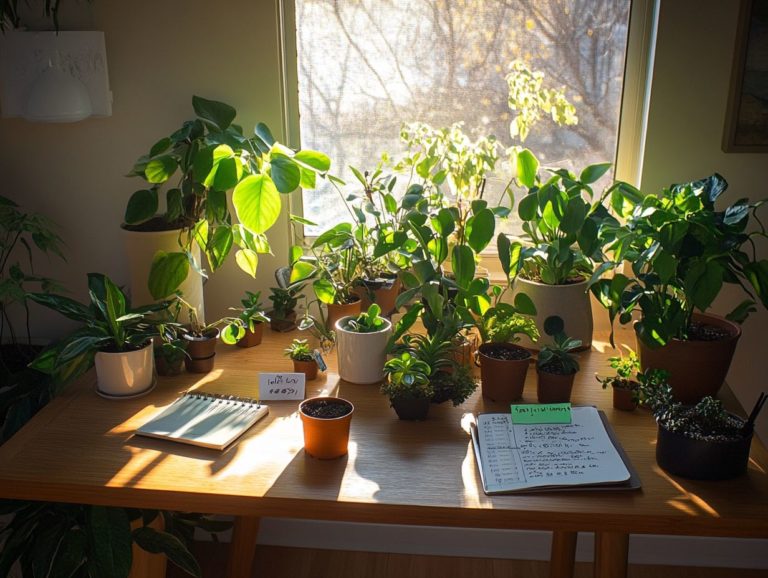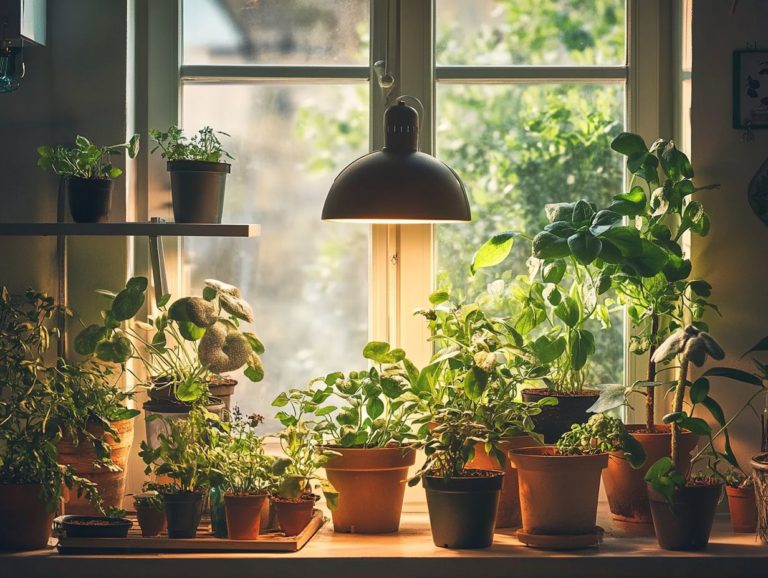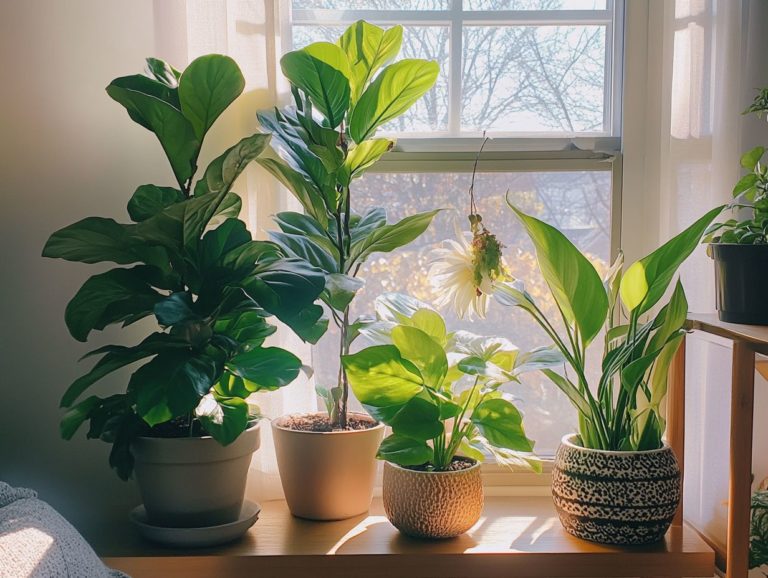The Best Light Arrangements for Houseplants
Lighting plays a vital role in the health of your houseplants. The intricacies of natural versus artificial light can often feel overwhelming.
This guide provides essential insights, from understanding your plants’ specific lighting needs to discovering optimal arrangements for different light levels.
Explore the various types of artificial lights available, learn to position your plants effectively, and receive expert tips for adapting to seasonal changes.
By the end, you ll be excited to craft the perfect lighting for your leafy friends!
Contents
- Key Takeaways:
- 1. Natural Light vs Artificial Light
- 2. Understanding the Lighting Needs of Houseplants
- 3. Types of Artificial Light Sources for Houseplants
- 4. Best Light Arrangements for Low Light Houseplants
- 5. Best Light Arrangements for Medium Light Houseplants
- 6. Best Light Arrangements for High Light Houseplants
- 7. How to Position Your Houseplants for Optimal Lighting
- 8. Common Mistakes When Lighting Houseplants
- 9. How to Adjust Lighting for Seasonal Changes
- 10. Tips for Using Grow Lights for Houseplants
- 11. How to Tell If Your Houseplant Is Getting Enough Light
- 12. Signs of Too Much Light for Houseplants
- 13. Signs of Not Enough Light for Houseplants
- 14. How to Troubleshoot Lighting Issues for Houseplants
- Frequently Asked Questions
- 1. What is the best light arrangement for houseplants?
- 2. How much sunlight do houseplants need?
- 3. Can I use only artificial light for my houseplants?
- 4. Which direction should I place my houseplants for the best light?
- 5. What types of artificial light are best for houseplants?
- 6. How do I know if my houseplants are getting enough light?
Key Takeaways:
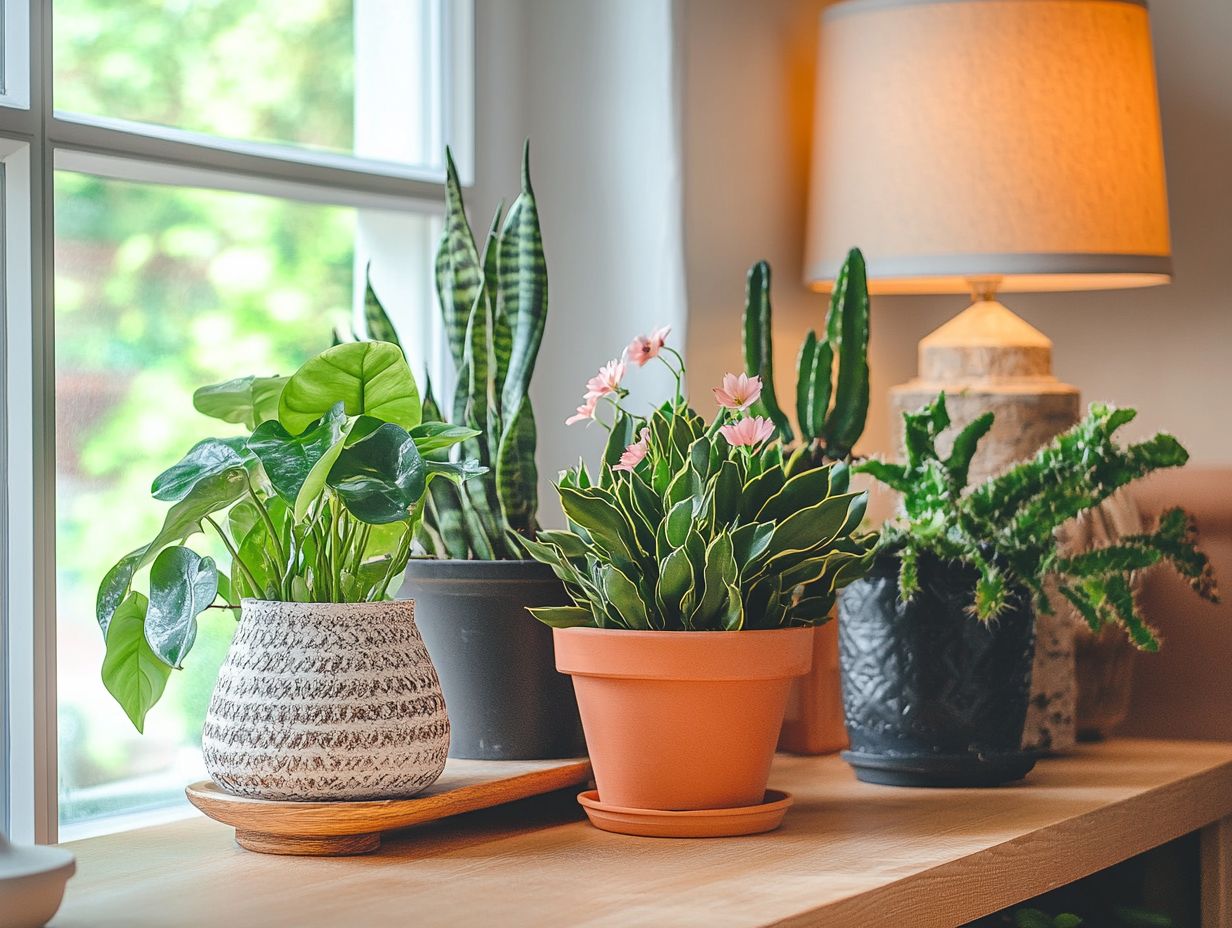
- Natural light is ideal for most houseplants. However, artificial light can be a great backup.
- Understanding the lighting needs of your houseplants is crucial for their health and growth.
- Position your houseplants according to their specific light requirements for optimal growth. Avoid common mistakes when lighting them.
1. Natural Light vs Artificial Light
Understanding the distinction between natural light and artificial light is crucial for success in indoor gardening. Houseplants often have specific light requirements to thrive, especially in spaces where natural sunlight is scarce.
This consideration is vital for urban gardening enthusiasts who rely on grow lights to create ideal growth conditions for a variety of plants, such as basil, tomatoes, and spinach seedlings.
Use artificial sources like LED bulbs to mimic the light spectrum necessary for photosynthesis. Windows alone might not provide enough light.
Natural sunlight is a vibrant and cost-free asset that fosters plant growth in its unique way. The adaptability of grow lights enables you to cultivate plants year-round, regardless of the weather outside.
It s important to weigh the benefits, such as precise control over light intensity, against potential downsides like energy consumption and heat output.
When choosing the right grow lights, understanding the differences among the various types available will ensure that your plants remain healthy and vibrant.
2. Understanding the Lighting Needs of Houseplants
To nurture thriving indoor plants, understanding their unique lighting needs is essential. Each houseplant has specific light requirements that directly affect its growth and health.
Different plant species thrive under various light intensities. For instance, low-light varieties like snake plants and pothos thrive in dimmer conditions. Sun-loving species, such as succulents and citrus, crave bright, direct sunlight.
Evaluate not only the brightness of the light but also the duration your plants receive it daily. Seasonal changes can significantly influence their growth cycles.
For optimal conditions, be mindful of seasonal shifts and adjust light placement accordingly. Position your plants near windows or supplement them with grow lights during shorter days.
By fine-tuning these light settings, you can create an inviting environment that fosters robust growth and vitality in your indoor garden.
3. Types of Artificial Light Sources for Houseplants
Artificial light sources, like LED bulbs and specialized grow lights, play an essential role in your indoor gardening journey. They provide the crucial light colors and spectra that cater to the unique needs of your houseplants.
When selecting the right lighting, consider factors such as wattage, color spectrum, and energy efficiency.
LED bulbs, especially from trusted brands like Mars Hydro, offer low wattage options that consume less energy while still delivering the optimal light necessary for growth. Products from AeroGarden present a broader light spectrum, enhancing photosynthesis and promoting overall plant health.
Both options address the challenges of insufficient natural light, enabling your houseplants to thrive and flourish. By comparing these choices, including using light shades for indoor plants, you can make a more informed decision that aligns perfectly with the specific requirements of your plants.
4. Best Light Arrangements for Low Light Houseplants
Creating the optimal light arrangements for your low light houseplants is essential for helping them thrive. Enjoy the vibrant greenery of your plants, even in shaded corners of your urban garden.
Understanding how to effectively arrange your light sources can significantly boost the health of these resilient plants. Position your lights at the right distance from the foliage; too close risks scorching the leaves, while too far may leave your plants yearning for essential illumination. For optimal choices, explore the top indoor plants for varied lighting.
Using light timers simplifies plant care by automating consistent schedules that mimic natural sunlight patterns. This promotes healthier development. For cozy spaces, consider varieties like pothos, snake plants, and peace lilies. They thrive in low light and add a vibrant touch while being easy to care for.
5. Best Light Arrangements for Medium Light Houseplants

Medium light houseplants flourish with light arrangements finely tuned to balance intensity and placement. This ensures they receive the right amount of illumination for optimal growth while avoiding light stress.
To achieve this balance, consider light fixtures like LED grow lights, fluorescent tubes, or strategically positioned floor lamps. Position these fixtures at an appropriate height so your pothos and spider plants can soak up just the right amount of light. For optimal results, refer to using sunlight for indoor plants effectively and aim for a distance of 12 to 24 inches between the light source and your plants, adjusting based on their preferences.
Grouping plants with similar light requirements facilitates effective light distribution and enhances the overall aesthetic of your space.
6. Best Light Arrangements for High Light Houseplants
To ensure your high light houseplants reach their full potential, implement optimal light arrangements that maximize both light duration and intensity while considering their specific growth requirements.
Different plant types have unique preferences; some may crave 14 to 16 hours of light daily, while others thrive on a more moderate 10 to 12 hours. For example, succulents bask in bright light for longer periods, whereas certain tropical plants may prefer filtered sunlight.
Position grow lights ideally 12 to 24 inches above the plants to achieve uniform coverage without risking leaf burn. Incorporating light timers to automate the schedule ensures your plants receive consistent exposure, promoting healthy growth and vibrant foliage.
This tailored approach allows each of your high light houseplants to flourish magnificently in their indoor environment.
7. How to Position Your Houseplants for Optimal Lighting
Properly positioning your houseplants is essential for achieving optimal lighting, which plays a crucial role in their growth and photosynthesis. Ensure they receive the right light intensity for vibrant development.
Consider the varying light conditions throughout your home, as these can differ greatly from room to room. For instance, south-facing windows typically offer the brightest light, while north-facing ones may provide a more subdued glow. Observe the sunlit hours different areas receive during the day. Using a light meter, which measures how much light a specific area receives, can be a game-changer in accurately measuring light intensity.
As the seasons shift, so does light exposure. Adjust your plant placements accordingly to maximize growth. For example, moving your plants closer to the windows during winter can allow them to soak up more light when natural sunlight is at a premium.
Try these tips immediately for better plant health!
8. Common Mistakes When Lighting Houseplants
Many indoor gardening enthusiasts often stumble into common lighting pitfalls that can significantly impact the health of their houseplants. Whether it s improper light intensity or poor placement, these mistakes can stifle growth and lead to adverse effects.
These issues frequently arise from either overexposing plants to harsh sunlight or neglecting to reposition them as the seasons shift. Different species have unique light needs; following general rules can spell disaster for your green companions.
Overlooking the connection between watering techniques and light exposure adds yet another layer of complexity. Even well-lit plants may struggle if their watering routine doesn t align with evaporation rates.
By honing in on these details and fine-tuning your care regimen, you can create a thriving indoor ecosystem that boosts plant vitality and elevates the aesthetic charm of your space. Start adjusting your lighting today and watch your plants thrive!
9. How to Adjust Lighting for Seasonal Changes
Adjusting lighting for seasonal changes is crucial in your indoor gardening journey, as fluctuations in natural light directly impact the duration and intensity of light your houseplants receive throughout the year.
To navigate these variations effectively, regularly assess your indoor environment, paying careful attention to the length of daylight and the angle at which sunlight streams into your space.
During the shorter days of fall and winter, many gardeners find it beneficial to increase the duration and intensity of artificial lighting to compensate for the diminished natural light. Utilizing light timers makes this process easier by automating the on and off cycles, ensuring your plants enjoy consistent exposure.
Experts suggest that you adjust light duration gradually; sudden changes can create unnecessary stress for your plants. By maintaining optimal conditions, including proper temperature and humidity, you can foster healthier growth, enabling your indoor plants to thrive even amidst the challenges of seasonal shifts.
10. Tips for Using Grow Lights for Houseplants

Employing grow lights effectively can elevate your indoor space into a flourishing garden, giving your houseplants the precise light they need for optimal growth and robust health.
To truly maximize these benefits, it s crucial to adjust the duration of light exposure according to the specific needs of your various plant types. Utilizing light timers can streamline this process, ensuring your plants bask in consistent light without the risk of overexposure.
Choosing the right type of lighting setups whether LED or fluorescent tailored to your plants light requirements can create a remarkable impact. Regularly monitoring your plants’ health allows you to make real-time adjustments, ensuring that each species thrives in its environment.
This flexibility transforms your home into a lush sanctuary, brimming with both greenery and vitality. Your plants deserve the best, so let’s ensure they get the light they need!
11. How to Tell If Your Houseplant Is Getting Enough Light
Determining whether your houseplant is receiving sufficient light is essential for its overall health. A well-lit plant will display specific signs of growth and vitality that you can easily observe. By paying attention to these visual cues, you can identify which plants thrive in their current environment and deepen your indoor gardening experience.
Take, for example, the vibrant green leaves of a pothos. When it s getting the right amount of light, you’ll notice its leaves becoming lush and expansive. However, if the foliage starts to turn yellow or becomes leggy, that’s your cue that it might be craving more light.
Similarly, succulents, with their thick, fleshy leaves, tend to show vibrant coloring and compact growth patterns when they enjoy bright, indirect sunlight. Keeping an eye on these changes in growth patterns is crucial. By doing so, you can easily adjust their positioning or light sources to cater to your plant s specific needs effectively.
12. Signs of Too Much Light for Houseplants
Recognizing the signs of too much light for your houseplants is crucial for maintaining their health. Excessive light intensity can lead to stress and stunted growth. Spotting these warning signs early can help you prevent irreversible damage and cultivate a thriving indoor garden.
Symptoms like leaf burn, characterized by crispy edges or browning tips, serve as clear indicators that your plant is overwhelmed by brightness. Discoloration or fading of leaves may suggest that your foliage is struggling to cope. It’s essential to monitor the arrangement of your plants and their proximity to windows or artificial lights to effectively mitigate these issues.
To adjust lighting, consider relocating your houseplant to a spot with indirect sunlight or using sheer curtains to diffuse those harsh rays. You might also explore adjusting the angle of your artificial lights or incorporating devices that reduce light. For more detailed guidance, check out understanding indoor plant light needs. Regularly rotating your plants helps all sides receive balanced light exposure.
Pay close attention to each plant s light needs to help them thrive! This will steer them clear of the adverse effects of excessive light.
13. Signs of Not Enough Light for Houseplants
Identifying the signs that your houseplants aren t getting enough light is essential for successful indoor gardening. Insufficient light can stifle growth and trigger a range of distress signals.
When your plants lack adequate illumination, you might notice their growth stalling, resulting in stunted leaves and an overall lackluster appearance. You may even see their stems stretching unusually tall and becoming leggy, which means they are searching for more light.
Keep an eye out for faded or yellowing leaves; these are red flags that the light levels aren t meeting your plant s needs.
To resolve these issues, consider relocating your plant to a brighter spot, perhaps near a window with filtered sunlight, or investing in grow lights that mimic natural light. Rotating your plants periodically ensures they receive equal light exposure, promoting balanced growth.
Adjusting the distance from light sources and keeping the leaves clean for optimal light absorption are practical steps you can take to enhance your indoor lighting conditions.
14. How to Troubleshoot Lighting Issues for Houseplants
Effectively troubleshooting lighting issues for your houseplants is crucial for maintaining their health. Improper light placement or intensity can lead to significant growth challenges.
You might notice these challenges appearing as leggy growth, yellowing leaves, or even a complete standstill in development. To tackle these concerns, it’s essential to assess the specific light requirements for each plant species.
Consider adjusting your light fixtures or repositioning your plants to meet their unique needs. This could mean moving pots closer to windows or using grow lights for those plants that thrive in brighter conditions.
Regularly monitor your plants for changes in color and growth patterns. This will offer valuable insights, enabling you to make timely adjustments and ensure your indoor garden flourishes.
Frequently Asked Questions
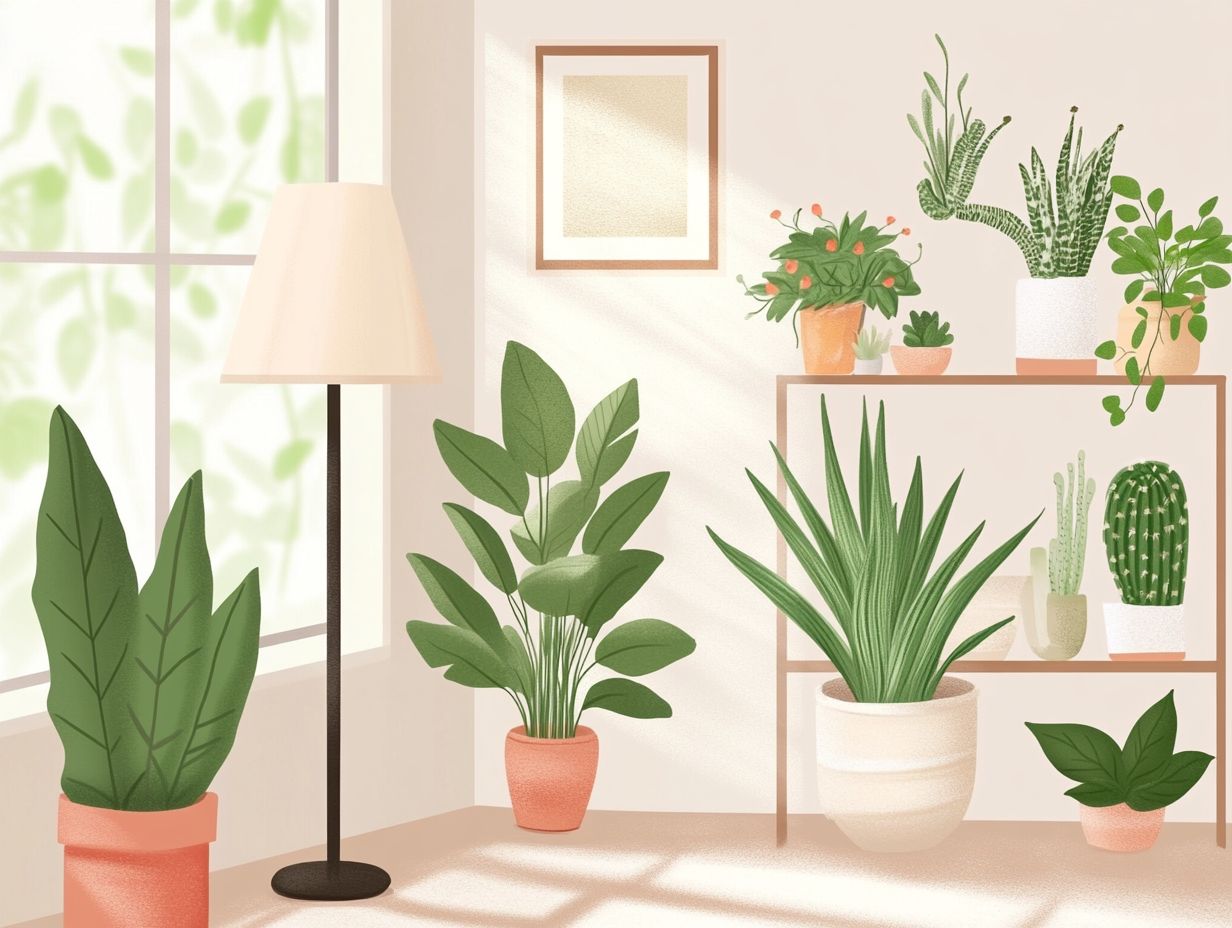
1. What is the best light arrangement for houseplants?
The best light arrangement for houseplants is a combination of natural sunlight and artificial light. This combination provides the right light for healthy growth.
2. How much sunlight do houseplants need?
This depends on the specific plant, but most houseplants need at least 6-8 hours of indirect sunlight per day. Some plants may require more or less, so it’s important to research the specific needs of your plant.
3. Can I use only artificial light for my houseplants?
While houseplants can survive with only artificial light, it’s not recommended. Natural sunlight provides a wider spectrum of light that is necessary for proper plant growth and health.
4. Which direction should I place my houseplants for the best light?
For most houseplants, placing them near a west or south-facing window is ideal. This will provide them with enough sunlight without the risk of direct sunlight that can be too harsh for some plants.
5. What types of artificial light are best for houseplants?
The two most important factors to consider when choosing artificial light for houseplants are the type of light and its intensity.
Full-spectrum LED lights or fluorescent lights are excellent choices for keeping your plants healthy and happy.
6. How do I know if my houseplants are getting enough light?
Healthy houseplants have vibrant foliage and might even bloom. If you notice yellowing leaves or leaf drop, your plants may not be getting the right amount of light.
Adjust your light setup to meet their needs!

